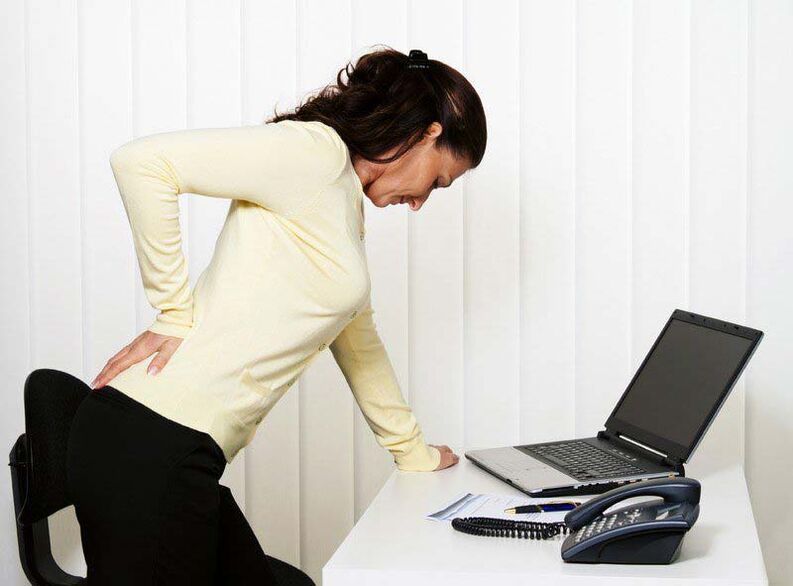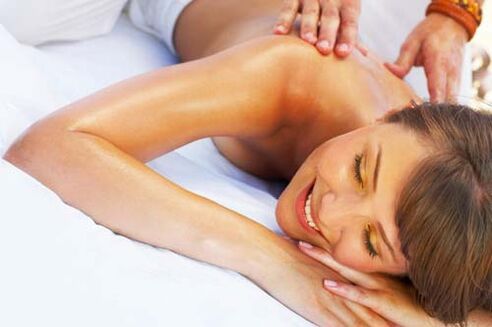This disease usually means systemic dystrophic disorders of the joint cartilage, manifested in the area between the vertebrae. According to the local arrangement of this problem, cervical, chest and lumbar types are distinguished.
What is osteochondrosis?

Osteocondrosis is a complex problem, it cannot be treated quickly. The cause of the problem is a sedentary lifestyle that contributes at the beginning of negative processes in the cartilage of the joints. Remember that as the human body grows, in the intervertebral discs a powerful vascular channel is formed with widespread nutrition. Any state and negative processes worsen the nutrition of the vascular direction and form a series of factors that aggravate the development of the pathology.
The physiological factors that contribute to the formation of osteochondrosis, you can see a bad nutrition, an increase in loads on the back and its injuries, unusual constant, flat feet, obesity.
Symptoms
The symptoms of osteocondrosis seem to be this:
- Lomota and numbness of the legs/arms, severe back pain.
- Significant increase in pain in physical effort and even cough.
- The antispasmodic state of the knitting muscles, a decrease in the activity of the movement.
- Other systemic manifestations characteristic in case of damage to a certain area of the spine.
The main reasons
- Degenerative changes related to age.
- Genetic and hereditary predispositions.
- Light weight.
- Poor nutrition.
- Infectious and intoxicative lesions.
- Metabolic imbalance.
- A sedentary lifestyle.
- Traumatic syndromes in the spine.
- Overload the spinal system due to active training, weight lifting, improper posture, pregnancy, wearing uncomfortable shoes.
- Strong stress, neuralgic overvoltage, smoke.
- Poor environmental conditions of permanent residence.
- The instability of the bone skeleton, flat feet.
Basic species
The main types of osteochondrosis include:
Osteochondrosis of the cervical column
Pathological transformations in the discs between the vertebrae in the cervical column, or rather its superior third. Very often caused by improper posture, metabolic disorders, weak muscle skeleton, the wrong lifestyle in general. The patient feels pain behind them and hands, periodically suffers from migraine. Almost always, the so -called "vertebral artery syndrome" caused by its spasmodic compression reactions: a pulsating headache, dizziness, flicker of the optical defects before her eyes and her hands are numbered.
Thoracic osteochondosis
The pathological condition with localization in the second third of the spine. Practical is always accompanied by the pain and discomfort-lubricated syndromes concomitant in the thoracic spine, intensifying during the inclination of the body or deep breath, as well as acute attacks on the affected spine, a strong deterioration of breathing due to pain, as well as its return to the chest, the neck and the lower part of the back. Often this problem induces pathologies to other organs: the heart, liver, kidneys and pancreas. Read more about the osteochondosis in the breast.
Lumbosacral osteochondosis
In this case, the pain syndrome is observed in the area specified with the "bastards" in the concomitant departments, legislation of the legs, negative manifestations in the vascular system and calves. The symptoms have improved in a vertical position, inclinations, strong cough. This type of osteochondrosis causes muscle weakness, painful sensations and pathologies of the pelvic organs, serious inflammation of the sacred and the lower part of the back.
Prevention
The prevention of osteocondrosis is desirable from an early age, especially if a person has a hereditary predisposition to this disease.
Basic thesis:
- Medical physical education.
- I swim.
- Car -Maps of the potentially problematic area.
- Compliance with recommendations for normalization of posture.
- Removal of the tension in the area.
- Morning gymnastics.
- Weight normalization and correct nutrition.
Treatment of osteocondrosis
The treatment of osteocondrosis, regardless of its stadium, is complex.
Pharmacological treatment
The main direction of drug therapy is to eliminate the unpleasant symptoms of the problem and increase the positive effect of other procedures. The preparations for local and systemic use not only eliminate pain, but also improve blood circulation, relieves inflammation, partially restore problematic cartilage, relax muscle complexes.
- Pills. Analgesic drugs in the form of analgesics and fans. Preparations are also prescribed that restore the cartilage fabric.
- Local external funds. Very often they are ointments and creams. The most requested with osteochondrosis are steroid hormonal drugs based on prednisolone or hydrocortisone complex gels.
- Injections. Injections for osteochondrosis are generally used in the acute phase of the disease, when the classic tablet and the local forms of dosage do not have the adequate effect on the body. The vast majority of injections aim to eliminate very serious pain syndromes. The classic use scheme is a special block with the introduction of anesthetic subcutaneously and therefore intramuscular in the area of the spinal nerves. These injections can only be performed in the hospital.
Exercises (LFK)

Therapeutic gymnastics is an important phase in the fight against osteochondosis. Operating therapy is prescribed by a doctor who is purely taking into account the specifications of the disease and the current conditions of the patient, as a rule, in the phase of remission of the problem.
The main objective of these exercises is the strengthening of the back muscles and the development of components of the damaged cartilage of the joints. Exercise uses various methods, but one of the most popular, is considered a scheme of two dozens of exercises according to the well -known therapist known in the past. The complex usually includes general strengthening classes, measures on targeted treatment for problematic areas, as well as "headlights" exercises that allow to evaluate the effectiveness of the treatment. The exact list of actions, their sequence, quantity and other initial data, provides the attending physician personally for the patient!
Osteochondrosis massage
The massage procedures for osteochondosis significantly facilitate the unpleasant symptoms of the disease and at the same time help to overcome the problem in combination with other measures.
Separate elements of massage and approaches in its implementation may differ according to the location of the osteocondrosis, its course, the presence of a patient in chronic diseases, etc.
Very often the therapeutic classics, points, connection, hardware and massages are often used. The above measures aim to improve the circulation of lymph/blood, normalize the power of vertebrates, remove pain syndromes, launch special fibers, relaxation of muscle mass, restoration of the nutrition of soft tissues, etc.
The use of osteochondosis massage should be refused if the patient has aneurysms, tumors, thrombosis, osteomyelitis, blood diseases, tuberculosis, sexual transmission diseases, problems with pelvic organs with osteochondosis, various manifestations of mass skin in the form of warts, erectic.
Traditional medicine
Popular medicine has actually treated osteochondrosis for centuries, as a rule, with the help of compressions and dyes inside.
The most popular recipes:
- Mix the grated raw potatoes and honey in a proportion from 1 to 1. Apply to the area of the problem for two hours in the form of a compress.
- Prepare a spoonful of chopped strawberries in a glass of boiling water, insists for twenty minutes and then uses on an empty stomach. Take for three months.
- Dissolve 300 grams of watermelon pulp, 200 grams of soda in a hot bath and take it for half an hour. The course is designed for 20 procedures.
- Pour ten grams of thyme with boiling water and take half a glass 2 times a day.




































